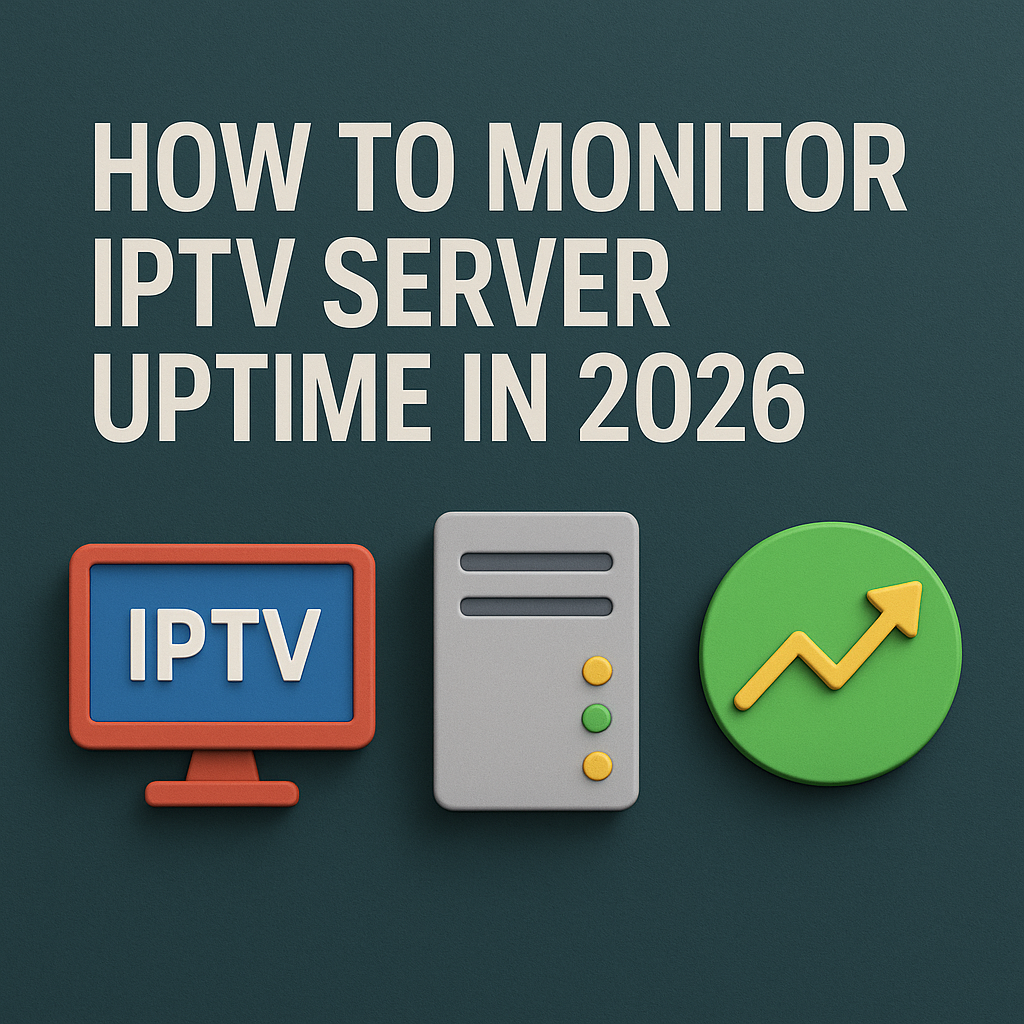How to Monitor IPTV Server Uptime in 2026

📊 Introduction: Why Uptime Is Your IPTV Lifeline
Nothing kills the viewing experience faster than a frozen stream. That’s why learning How to Monitor IPTV Server Uptime in 2026 is essential if you want consistent, reliable IPTV performance. Uptime monitoring tells you whether your servers (or your provider’s endpoints) are reachable, how fast they respond, and when they fail—so you can react before users notice.
In this guide, you’ll set clear targets (SLA/SLO), track key metrics (uptime %, latency, error rates), and build an alerting pipeline that catches issues in real time. Whether you’re a power user, a family admin, or running a small IPTV setup, this framework will keep your streams online.
🚀 Why Monitoring Uptime Matters for IPTV
🎯 What “good” looks like
- Uptime target: 99.9% or better for primary endpoints.
- Startup time: HLS/MPD playback should begin within 2–4 seconds.
- Error budget: Define a monthly allowance for downtime and 5xx errors.
📈 Metrics that actually move the needle
- Availability %: Total time an endpoint is healthy.
- Latency: DNS + TLS + first byte + playlist/segment fetch.
- Error rate: 4xx/5xx responses, stalled segments, manifest fetch failures.
- Jitter/packet loss (LAN/WAN): Impacts smooth playback, especially for 4K.
- MTTR / MTBF: Mean time to recover, mean time between failures.
🧪 What to probe (synthetics)
- HTTP checks: Manifest URLs (.m3u8/.mpd) return 200 and valid content.
- Segment checks: Latest segments appear on schedule and download within threshold.
- DNS & TLS: Resolve time, cert validity/expiry, handshake latency.
- Edge regions: Test from multiple geos to catch CDN-edge issues early.
🛠️ Step 1 — Choose Your Monitoring Stack (2026-ready)
Start with a layered approach: external uptime probes, internal player telemetry, and network health. This gives you a 360° view of failures—from DNS to the last mile.
🌐 A) External Uptime & API Monitors
- Set HTTP checks on playlist endpoints and channel APIs.
- Validate response codes, body patterns (e.g., #EXTM3U), and max latency.
- Schedule checks every 1–5 minutes from multiple regions.
📺 B) Stream-Level Synthetic Tests
- Fetch manifests and the newest N segments; fail if segments stall or are missing.
- Track segment age (live edge drift) and average download time.
- Alert when segment download time exceeds your playback buffer budget.
📶 C) Network & Home Infrastructure
- Monitor router WAN uptime, jitter, packet loss, and throughput.
- For large homes, track mesh/AP signal quality and backhaul saturation.
- Set alerts for ISP outages and high-latency spikes during peak hours.
🔔 D) Alerting & Escalation
- Routing: Send P1 alerts (total outage) to push/SMS; P2 (degraded) to chat/email.
- Noise control: Require failure from 2+ regions before paging (avoid false alarms).
- Runbooks: Link each alert to a short, actionable checklist.
📜 E) SLOs & Reporting
- Monthly uptime report with error budget burn-down.
- Top incidents (root cause, time to detect, time to resolve).
- Capacity notes: peak concurrent streams vs. network limits.
With this stack in place, you’ll have a proactive system that detects issues before viewers complain, which is the whole point of How to Monitor IPTV Server Uptime in 2026.
🔧 Step 2 — Setting Up Practical Uptime Checks
After you’ve chosen your monitoring stack, it’s time to put it into action. The best practice is to test IPTV endpoints at multiple layers:
- DNS Monitoring: Ensure your IPTV domains resolve quickly and consistently.
- HTTP Uptime: Ping .m3u8 or .mpd manifest URLs every minute.
- Content Validation: Confirm the response contains #EXTM3U or playlist tags.
- Segment Checks: Fetch the latest 2–3 video segments and validate download speed.
- End-to-End Testing: Launch playback from a synthetic player probe.
This layered strategy ensures you don’t just know if a server is “up,” but if it’s usable.
🚨 Step 3 — Define Thresholds and Alerts
Monitoring without alerts is pointless. You need thresholds to decide when to act:
- Availability: Alert if uptime < 99.5% in rolling 24 hours.
- Latency: Alert if playlist fetch > 3s or segment > 2s.
- Error Rate: Alert if 5xx > 1% of total checks in 15 minutes.
- Regional Failures: Require 2+ probe regions to fail before paging (to avoid false positives).
Alerts should be routed with severity:
P1 (major outage) → SMS/Push
P2 (degraded performance) → Email/Chat
⚡ Quick Fixes When IPTV Uptime Dips
🔄 Restart Services
Restart the IPTV app, clear its cache, or reboot your device. Many small issues vanish with a reset.
🌐 Switch Endpoints
Some providers give multiple portals or domains. Switch if one is unstable.
📡 Check Local Network
ISP congestion often looks like a server outage. Run a speed test to confirm.
🛡️ Use a VPN
Regional throttling can cause downtime. A VPN often restores connectivity.
📞 Contact Support
If uptime monitoring confirms repeated outages, escalate to your provider with logs.
🔍 Reality Check: The Limits of Uptime Monitoring
Even with the best monitoring tools, you can’t guarantee 100% IPTV availability. Free servers often cut corners, CDNs may experience regional outages, and ISPs sometimes throttle IPTV traffic. Monitoring helps you detect problems quickly, but fixing them often requires a reliable provider.
Remember: uptime monitoring is only as good as the infrastructure behind it.
❓ FAQ: IPTV Uptime Monitoring in 2026
1. What is “uptime” in IPTV?
It’s the percentage of time IPTV servers are reachable and streaming without errors.
2. What’s a good uptime percentage?
Look for at least 99.9% monthly uptime. Anything lower risks interruptions.
3. Can I monitor uptime without technical skills?
Yes, apps and dashboards exist that provide simple health checks with alerts.
4. Why does my IPTV buffer even when uptime is 100%?
Because buffering can be caused by ISP throttling, weak Wi-Fi, or device issues—not just server downtime.
5. Do I need to monitor multiple servers?
If your provider uses load balancing or multiple portals, yes—it ensures redundancy.
6. Are free monitoring tools enough?
For casual users, yes. For serious IPTV setups, premium monitoring provides better reliability.
7. Does monitoring consume bandwidth?
No, it only fetches playlists or small video segments—it’s lightweight.
8. Can I get alerts on my phone?
Yes, most monitoring services support push, SMS, or email alerts.
9. How often should I check uptime?
Every 1–5 minutes for critical endpoints, hourly for non-critical.
10. Can VPN affect uptime monitoring?
Yes, if the VPN slows down your connection, it may look like a server issue.
✅ Final Verdict
Knowing How to Monitor IPTV Server Uptime in 2026 means fewer surprises, smoother streams, and happier viewers. With a solid monitoring setup, you’ll detect outages in minutes instead of hours, and you’ll know whether the issue is with your device, network, or provider.
Still, monitoring can only go so far. If your IPTV provider struggles with stability, it may be time to upgrade. For a reliable experience, check out this premium IPTV option 👉 Premium IPTV Subscription .






